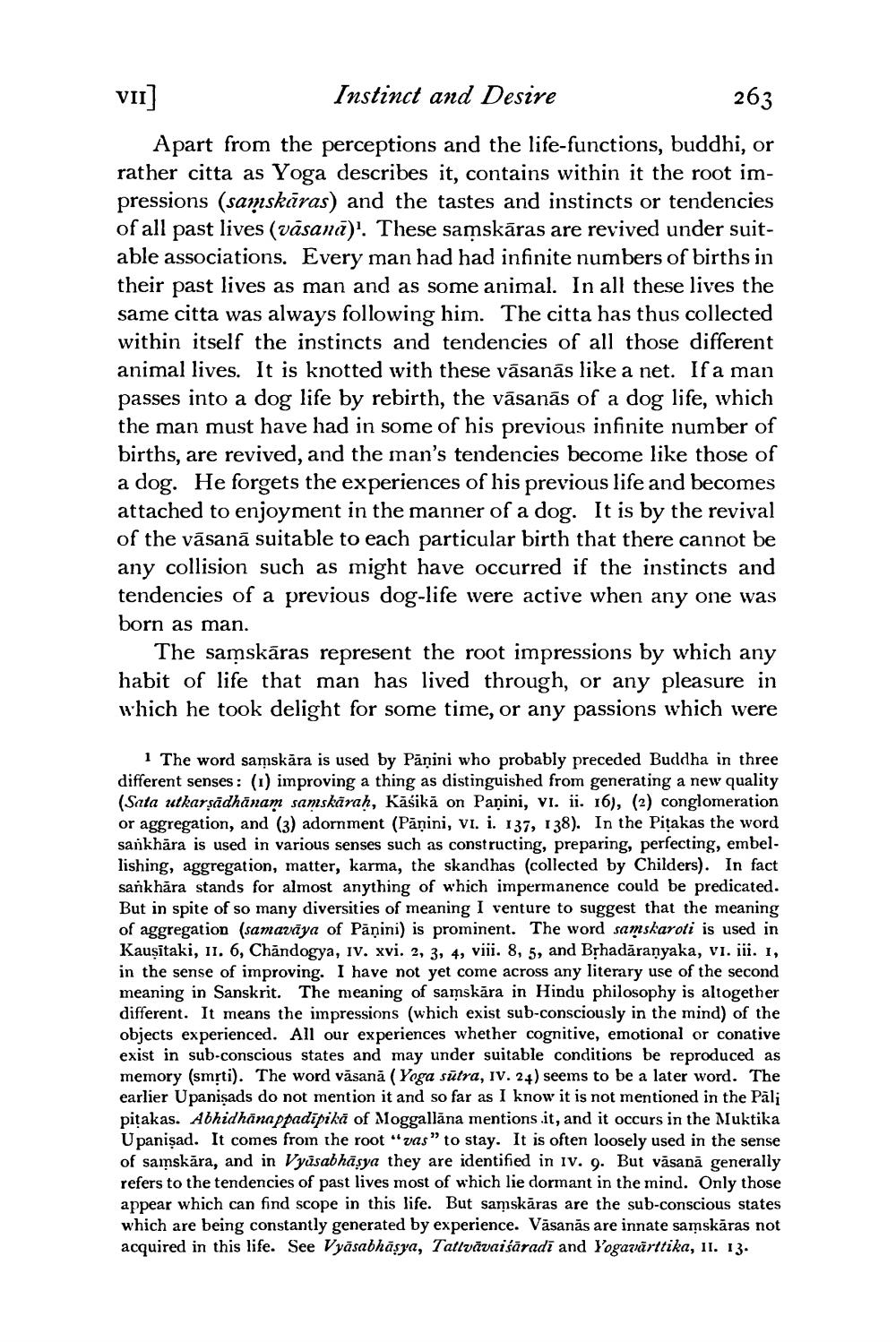________________
VII]
Instinct and Desire
263
Apart from the perceptions and the life-functions, buddhi, or rather citta as Yoga describes it, contains within it the root impressions (samskāras) and the tastes and instincts or tendencies of all past lives (vāsanā)'. These samskāras are revived under suitable associations. Every man had had infinite numbers of births in their past lives as man and as some animal. In all these lives the same citta was always following him. The citta has thus collected within itself the instincts and tendencies of all those different animal lives. It is knotted with these vasanās like a net. If a man passes into a dog life by rebirth, the vāsanās of a dog life, which the man must have had in some of his previous infinite number of births, are revived, and the man's tendencies become like those of a dog. He forgets the experiences of his previous life and becomes attached to enjoyment in the manner of a dog. It is by the revival of the vasana suitable to each particular birth that there cannot be any collision such as might have occurred if the instincts and tendencies of a previous dog-life were active when any one was
born as man.
The samskāras represent the root impressions by which any habit of life that man has lived through, or any pleasure in which he took delight for some time, or any passions which were
1 The word samskāra is used by Panini who probably preceded Buddha in three different senses: (1) improving a thing as distinguished from generating a new quality (Sata utkarṣādhānam samskāraḥ, Kāšikā on Panini, VI. ii. 16), (2) conglomeration or aggregation, and (3) adornment (Pāņini, VI. i. 137, 138). In the Pitakas the word sankhāra is used in various senses such as constructing, preparing, perfecting, embellishing, aggregation, matter, karma, the skandhas (collected by Childers). In fact sankhāra stands for almost anything of which impermanence could be predicated. But in spite of so many diversities of meaning I venture to suggest that the meaning of aggregation (samavaya of Pāṇini) is prominent. The word samskaroti is used in Kauṣitaki, 11. 6, Chandogya, IV. xvi. 2, 3, 4, viii. 8, 5, and Bṛhadaraṇyaka, vi. iii. 1, in the sense of improving. I have not yet come across any literary use of the second meaning in Sanskrit. The meaning of samskara in Hindu philosophy is altogether different. It means the impressions (which exist sub-consciously in the mind) of the objects experienced. All our experiences whether cognitive, emotional or conative exist in sub-conscious states and may under suitable conditions be reproduced as memory (smṛti). The word vasana (Yoga sutra, IV. 24) seems to be a later word. The earlier Upanisads do not mention it and so far as I know it is not mentioned in the Pali piṭakas. Abhidhānappadīpikā of Moggallana mentions it, and it occurs in the Muktika Upanisad. It comes from the root "vas" to stay. It is often loosely used in the sense of samskara, and in Vyasabhāṣya they are identified in IV. 9. But vāsanā generally refers to the tendencies of past lives most of which lie dormant in the mind. Only those appear which can find scope in this life. But samskāras are the sub-conscious states which are being constantly generated by experience. Vāsanās are innate samskāras not acquired in this life. See Vyasabhāṣya, Tattvāvaiśāradī and Yogavārttika, 11. 13.




